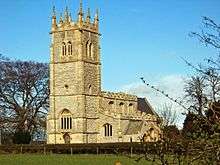All Saints' Church, Hawton
Coordinates: 53°03′05″N 00°49′33″W / 53.05139°N 0.82583°W
| All Saints' Church, Hawton | |
|---|---|
 All Saints' Church, Hawton | |
| Denomination | Church of England |
| Churchmanship | Broad Church |
| Website | www.farndon-hawton.org.uk |
| History | |
| Dedication | All Saints |
| Administration | |
| Parish | Hawton |
| Diocese | Southwell and Nottingham |
| Province | York |
| Clergy | |
| Rector | Rev David Milner |
All Saints' Church, Hawton, is a parish church in the Church of England in Hawton, Nottinghamshire.
The church is Grade I listed[1] by the Department for Culture, Media & Sport as a building of outstanding architectural or historic interest.
History
The church is medieval and the chancel is described by Nikolaus Pevsner as one of the most exciting pieces of architecture in the country..[2]
On the north side of the chancel is a medieval Easter Sepulchre. Opposite on the south side is the sedilia. The carvings on these two features are considered amongst the best in England.[3]
The carvings in the chancel are thought to be the work of stonemasons who worked on the choir screen and Chapter House in Southwell Minster.
Easter Sepulchre
Most famous is the Easter Sepulchre, which would have been used to reserve the consecrated bread and wine between Maundy Thursday and Easter Day, during which period there would have been no celebration of Holy Communion, and the consecrated elements would have been reserved in the Sepulchre. The carvings depict at the base the sleeping Roman soldiers guarding the tomb of Christ, at the top are the apostles gazing heavenward at his ascending feet. In between is the risen Christ, the graveclothes draped over his shoulder. Sadly the glorious stonemasonry suffered at the hands of Oliver Cromwell's men.
Sedilia
On the south wall of the chancel is the finely carved sedilia, originally provided for officiating clergy. At the very top are six saints standing on little men and animals, and crowned with angels. Lower are four female figures, then St Edward the Martyr, with a bishop on either side, and above are - on the left St Peter and, on the right St Nicholas. Further down still are two men on all fours gathering grapes among the foliage, and a pelican in her nest.[4]
Memorials
- Sir Robert de Compton, died 1330
Current parish status
It is in the United Benefice of Farndon with Thorpe and Hawton with Cotham:
- All Saints' Church, Hawton
- St. Lawrence's Church, Thorpe
- St. Peter's Church, Farndon
- St. Michael's Church, Cotham
Sources
| Wikimedia Commons has media related to All Saints, Hawton. |
- ↑ England Listed Building Record
- ↑ Pevsner, Nikolaus. 1979. The Buildings of England:Nottinghamshire. page 140. Harmondsworth, Middx. Penguin.
- ↑ 'Hawton Church and its Mysterious Chancel', Revd. John Quarrel
- ↑ The story of Hawton Church, Revd. John Quarrel, p.66, Newark & Sherwood District Council, 1994.